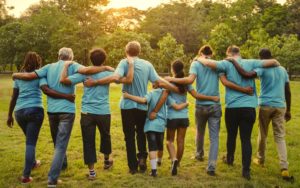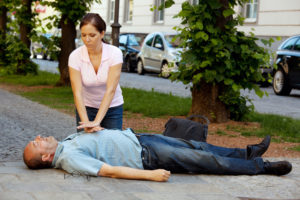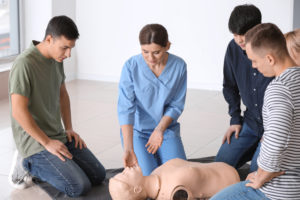Community service — it’s an activity we’ve all either heard about or been involved in at some point in our lives. It’s the fabric of a good society, the invisible hands that patch up holes, mend hearts, and rekindle hope. Yet, it’s more than just lending a hand. It’s about ensuring the safety of those we serve. That’s where Basic Life Support (BLS) comes in — a critical skill that’s as relevant to community service as the good intentions driving our efforts.
Understanding BLS: A Tool for Community Volunteers
Once during a community fair where my friend was volunteering at a health booth, a man collapsed nearby. Most people around were understandably panicked, but my friend had BLS training. He quickly started CPR and continued until the paramedics arrived. The man survived, and later my friend learned he had suffered a heart attack. Thats an example of the power of BLS training, not just in a clinical setting but also in the community at large.
BLS, though traditionally associated with healthcare professionals, isn’t limited to hospital corridors. In fact, it can be a game-changer on the field of community service, turning volunteers from good Samaritans to lifesavers. At its core, BLS includes crucial life-saving techniques such as CPR, handling choking emergencies, and using AEDs. These skills can be essential in community service scenarios — from a local charity race event to disaster relief efforts.
Why Community Volunteers Need BLS Training
Picture this, you’re at a community event, maybe it’s a charity race or a local fair, and suddenly, someone collapses. In the midst of the ensuing chaos, what do you do? Freeze or jump into action?
Emergencies don’t make appointments; they can occur anywhere, any time, and often when least expected. Community events are no exception. From choking to sudden cardiac arrest, the potential emergencies in community service environments can be diverse and life-threatening. That’s where Basic Life Support (BLS) training comes into play.
BLS training equips community volunteers with the knowledge and skills to react swiftly and effectively in such crisis scenarios. Knowing how to perform cardiopulmonary resuscitation (CPR), use an automated external defibrillator (AED), and manage choking cases can make the difference between life and death. When every second counts, immediate response from a BLS-trained bystander can be a game-changer. I’ve seen this firsthand in my nursing career, and it’s why United Medical Education advocates for widespread BLS training.
BLS Certification: Boosting Confidence and Capability in Volunteering
Remember that feeling you got when you aced a test in school? Confidence soaring through the roof, a sense of accomplishment? Now, imagine that on a larger scale – a scale where it’s not just a grade at stake but potentially someone’s life.
BLS certification can be that self-assurance boost for community volunteers. It’s more than a piece of paper – it signifies that you are prepared, capable, and ready to step up in a crisis. With the skills gained through BLS training, volunteers can approach their service with a heightened sense of confidence.
Moreover, BLS renewal online can transform the perceived challenge of handling emergencies into a solid capability. It equips volunteers with the ability to maintain composure, make swift decisions, and most importantly, save lives. From personal experience, I can vouch for the incredible surge of capability you feel when you can confidently step into a life-saving role.
The Role of BLS Certification in Enhancing Community Trust
Let’s switch gears and put ourselves in the shoes of community members. Who would you trust more in a crisis? A well-intentioned bystander or a volunteer equipped with the knowledge to intervene effectively?
Trust is the cornerstone of community service, and BLS certification can significantly bolster this trust. It sends a strong message to community members: “We are prepared, we are trained, and we are committed to your safety.” This commitment can foster a deep-seated trust and respect for volunteers among community members, enriching the overall volunteering experience.
Furthermore, BLS certification isn’t a one-and-done deal. It requires regular recertification, underscoring a volunteer’s dedication to continuous learning and updated life-saving skills. This commitment goes a long way in demonstrating a volunteer’s steadfast dedication to community safety.
At United Medical Education, we understand the value of this trust. That’s why we strive to make BLS training accessible to all, offering free training to those who build a free student account, and free practice exams to prepare for the final test. In building a community of BLS-trained volunteers, we’re not just imparting skills, but also nurturing trust and fostering safer communities.
As we’ve seen, BLS training isn’t just for healthcare professionals – it’s a life-saving skillset that every community volunteer can and should have in their toolkit. From boosting volunteers’ confidence and capability to enhancing community trust, the benefits of BLS certification are manifold. So, let’s equip ourselves with these vital skills and build safer, stronger communities together. After all, being ready to save a life is one of the most profound ways we can serve our communities.
While the concept of BLS might seem intimidating at first, trust me when I say it’s not as daunting as it sounds. My experience with BLS training, and watching others go through it, is a testament to this. United Medical Education simplifies the process, ensuring the knowledge is accessible and understandable to everyone, regardless of their medical background. Their free resources and practice exams are incredibly valuable tools to help you grasp the core principles and nuances of BLS.
Navigating BLS Certification: A Guide for Community Volunteers
In my nursing career, I’ve witnessed the power of BLS training countless times. I’ve seen it in the heartwarming gratitude of family members who could hug their loved one again because a BLS-trained bystander was at the right place at the right time. I’ve seen it in the relief washing over a parent’s face as a BLS-trained volunteer successfully helped their choking child.
But these are not just isolated incidents. They represent the transformative potential of BLS training and the significant impact it can have on community safety. We can multiply these lifesaving instances by equipping more community volunteers with BLS skills.
So, here’s my call to action for community volunteers: embrace the opportunity to get BLS-certified. It’s not merely an addition to your resume but a tangible demonstration of your commitment to the welfare of your community. Take advantage of resources like United Medical Education that make BLS training free and accessible.
Getting your BLS certification might seem daunting, but it doesn’t have to be. In fact, United Medical Education is here to make it as easy as possible. When you build your free student account, you gain access to a wealth of resources — comprehensive training modules, free practice exams, and a host of other tools to prepare you for the final exam. The journey to BLS certification isn’t a solitary one; we’re here to walk with you every step of the way.
The Lasting Impact of BLS Training in Community Volunteering
Community service is a profound expression of our commitment to the betterment of society. By adding BLS training to the mix, we not only amplify the value of our contribution but also underscore a key aspect of community — safety. In the end, the enduring benefit of BLS training isn’t just about dealing with emergencies — it’s about nurturing a safer, stronger, and more resilient community.




